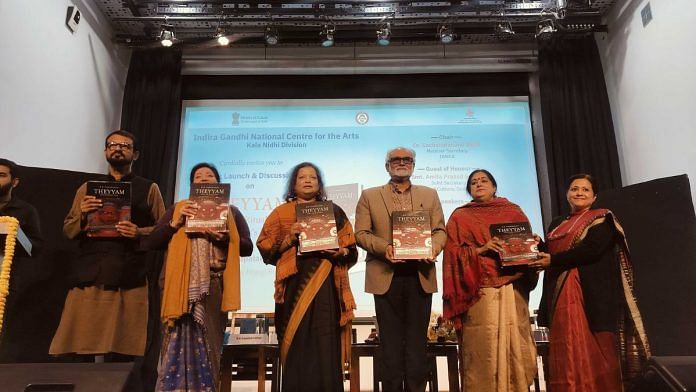New Delhi: Celebrated photographer KK Gopalakrishnan released his book, Theyyam in a barely occupied hall at the Indira Gandhi National Centre for the Arts. A celebration of the visual folk art and dance form that traces its roots to the northern districts of Kerala. But the author was unfazed by the low attendance at the launch.
“I know perhaps because of cold and traffic the audience is very less, but I am not surprised. When I was the director of the Centre for Koodiyattam at Sangeet Natak Academy, often there would be five to six artists on stage but hardly one or two people [in the audience]. We always believe that those who missed the performance are the losers, not the performer,” Gopalakrishnan said with a smile. And he was right.
Gopalakrishnan, whose family members are patrons of the Theyyam art, said that it was perhaps the first art form that he ever got to know. He spent three years documenting the sacred art form—the result, Theyyam, is a rich offering of photographs and reported testimonies, all underpinned by academic rigour.
Theyyam is an Indian folk visual theatre, usually performed by labourers, and has elements of nature, agriculture, spirit, ghosts and ancestor worship. Theyyams are typically performed by men, although most tell stories of fabled goddesses. Gopalakrishnan revealed that there is only one Theyyam performed by a woman, which takes place in December every year.
After a brief address by the author, the book was launched by the Indira Gandhi National Centre for the Arts (IGNCA) chairman Sachinanand Joshi, Joint Secretary of Culture Amita Prasad Sarbhai, art activist Arshiya Sethi and KE Priyamvada from the India Culture Centre.
“All thanks to KK for his constant and consistent support and writing on the arts. It is very important. There couldn’t have been a better person to write a book on Theyyam,” moderator for the show, ‘artivist’ Arshiya Sethi said.
Also read: Anand Hi Anand—an event celebrating Dev Anand and brothers is an opportunity half missed
Vanishing folk art
The discussion that followed Gopalakrishnan’s address was focussed on the preservation and promotion of vanishing folk art.
Joint Secretary Sarbhai spoke at length about the government’s seven zonal cultural centres and how they’re preserving various cultural folk art traditions. “Sangeet Natak Academy and IGNCA have made it our motto to select certain vanishing art forms in each state. We are staging programmes and more importantly documenting the traditions,” she said.
All of the centres have a guru shishya system. Students live at the centres where they master the art for a year.
Theyyam is among the vanishing art forms that the south zonal centres are focussing on. “The government wants to implement a proper policy focused on vanishing art forms, banking on cultural economy. Any art form will flourish only if it flourishes economically,” Sarbhai said.
Popular culture, movies and social media too play an important role in keeping traditions alive. As Sarbhai pointed out, the blockbuster hit Kantara (2022), adding that the movie has done great service to the Theyyam art form.
“We used to have V Shantaram movies showing Chaavu. Such depictions of folk art in movies have nearly vanished. Somewhere, it has to be a combined effort to save the folk arts,” she said.
The panellists also discussed if social media could attract the youth to folk art. But for that, dancers and videographers as well as organisers and the government will have to start posting reels and bite-sized videos.
There is a fine line between promotion and purity of these art forms. “I am completely in favour of commercialisation,” said Gopalakrishnan. But there is a caveat.
“As long as it doesn’t dampen the sacredness of the art.”
(Edited by Ratan Priya)






